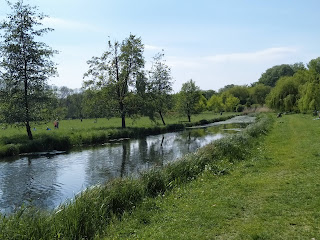I
hope to surprise you twofold:
1) this meadow is located just 10 min
by tram from the very city centre, (in my understanding this still
counts as a centre), across the Vistula river,
2) this meadow is a
historic monument.
This
is called Kamionkowskie Błonia Elekcyjne (the
Election Meadow of Kamion). Kamion is the name of a
neighbouring district, a village in the past. And „elections”
refer to the Polish custom of electing kings. Yes, while in most
kingdoms or principalities
power was hereditary, in Poland it was so only to a certain extent.
When the great dynasty of the Jagiellonians
left no male descendant in 1572, the Polish parliament decided to
elect their monarchs from then on. This tradition continued until the
fall of the first Polish Republic (1795). It was a kind of prototype
of democracy, save that in Poland the right to vote was cherished
only by noblemen. Nevertheless: ALL noblemen, no matter how high or
low their standing, as long as they could afford to come to Warsaw,
they could cast their vote in
the election.
(By the way,
do you remember the last episode of the Game of Thrones? I'm pretty
sure that the decision to choose future monarchs by Westerosi leaders
was inspired by the history of Poland! 😁 )
We
had 11 elected kings and some of them were foreigners. The first one
was a French prince by name of Henry of Valois (known in Poland as
Henryk Walezy; French: Henri III) – he was elected here on this
very field in 1573 (he didn't enjoy the title of the Polish king long
– once he heard of vacancy on the French throne, he left secretly
after four months! Much to his misfortune, as he was assasinated in
1589... none Polish king was ever assasinated, so I'd expect him to
have lived and prospered, had he remained in Poland).
Most
of subsequent elections took place on the other side of the river,
beside the village of Wola (now a district of Warsaw) – that place
is now commemorated by a monument. The
Election Meadow of Kamion saw one more election in 1733, when
August III, an elector of Saxony, was chosen here.
Then
for decades and centuries nothing much happened here. The place
remained more or less untouched, it partly served as municipal
pastures, as the urban area grew all around. In the 1920s a part of
this territory was turned into a park. The election meadow
constituted a seperate green part, especially since the 1960s when it
was turned into a landscape park,
with new plantings, creation of a pond etc. The park and the meadow
were registered as a historic monument in 1993 but it wasn't until
2013 that the meadow was officialy named and its historic value was
highlighted.
I
knew of its significance, but I was still surprised when I first got
to this corner of the park - to see such open space, an actual
meadow in the city centre. If it wasn't for the block of flats visible on the horizon line, one would believe to be well outside of
town.
On
one of recent warm weekends, there were lots of people doing sports,
having barbecues, sunbathing.... and still pretty safe, keeping the social
distancing rules :-)

















































